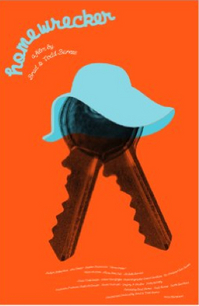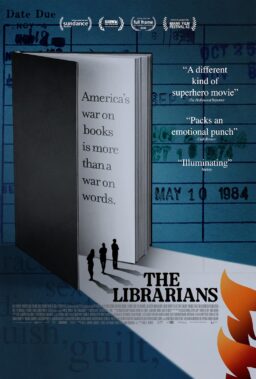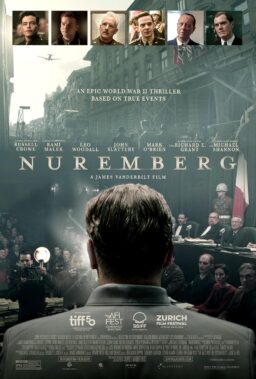
Scroll down for my earlier entries.
The first five Sundance entries I’ve seen are the kinds of film the festival exists to showcase. It is possible that many of them won’t ever open in most of the places you readers live, but you’ve impressed me with your resourcefulness in finding them anyway (and no, I don’t mean piracy). You guys demonstrate that if you want to find a movie badly enough, you often can.
One of them, “Homewrecker,” is for rent right now via YouTube, in keeping with the festival’s Reinvention/Rebirth/Renewal and its embrace of new distribution channels such as the net and regional art cinemas.
That one and “Armless” are playing in the new Sundance section named NEXT, which specializes in movies with “low to no budgets.” The guidelines specify budgets below $500,000, and both of these look closer to half a million than to “no.”
“White Plastic Flower” by Jamie Stuart, a wonderful short about the darker side of Sundance.
The one I’ve seen that could play your town is Nicole Holofcener’s “Please Give,” opening April 23. This is another of her lovingly observant studies in human nature, with women as usual in the foreground. Her focus is often the affluent–not the rich rich, but prospering urban professionals. Her heroine here, Kate (the peerless Catherine Keener), runs a mid-range “antique” furniture store, with a stock acquired largely from the children of aged widows. If the kids don’t know that mom’s old dining room table will sell for $5,000, that’s their fault.

Mary’s husband and business partner is Alex (Oliver Platt). They speak the same language. Their unhappy 15-year-old daughter Abby (Sarah Steele) is pudgy and spotty and smart, but not smart enough to deal with adolescence, as who is? They live next door to a 91-year-old woman named Andra (Ann Morgan Guilbert, herself only 81), and have an option to buy her apartment.
They’re eager for her to die so they can break down some walls, but in guilt invite her and her granddaughters Mary and Rebecca (Amanda Peet and Rebecca Hall) to dinner. Andra is a hostile, whiny, perpetually wronged full-time victim. Mary is like her grandma. Rebecca is more like Kate. From these beginnings and an urban facial and tanning spa Holofcener creates a funny and not uncritical comedy.

“Armless,” by the Pennsylvania filmmaker Habib Azar, is well and memorably titled. (It’s not one of those titles like “Extraordinary Measures” you can hardly link to a film). It stars the sad-faced Daniel London as John, a man who desperately wants to have his arms amputated. There are such people. On the internet they are mostly known as “amputee wannabes,” and not, thank God, “amputee done-its.” In a chat room he finds the name of a doctor (Matt Walton), who reportedly will perform the illegal operation. Leaving a farewell message to his wife (Janel Moloney), he goes to New York to find happiness.
Whether the doctor will perform the operation I leave to you, and John, to discover. Why he has such a low-rent office may be explained by the budgets of NEXT category; his receptionist (Zoe Lister Jones) barely has enough room on her desk for the magazine she won’t look up from. Why John wants to be armless is explained by the usual psychobabble (“I am an armed man with an armless man trapped inside.”) It’s not a wonder his film didn’t find studio financing; the screening was attended by what looked like busload of Azar’s backers, wearing matching red snow jackets and stocking caps, “who all invested a couple of hundred.” I would say they got more than their money’s worth. Based on the play by Kyle Jarrow; not a comedy only for wannabes.

“Homewrecker,” by the brothers Brad and Todd Barnes, is a comedy about two flywheels who meet through a New York locksmith service. Anslem Richardson plays Mike, the nicest, most honest and sincere ex-com you’d ever want to meet. He’s sent on a lock picking call from Margo (Ana Reeder), and doesn’t suspect she wants to break into her boyfriend’s apartment. Margo is a piece of work. In an inspired performance, Reeder gives us a cute, comely, terminally ditzy basket of insecurity, who involves the Mike in a series of adventures that are both unlikely and sort of inevitable.
The funniest scene comes after Margo convinces Mike to walk into an art district bistro, sit next to her boyfriend Charles (Stephen Rannazzisi), chat him up, and find out if he’s also dating another woman. This Mike very reluctantly does (he finds it impossible to out talk Margo). His conversation with Charles is all the funnier because, if you agree it could take place at all, probably sounds more or less than the real thing would. The film’s flaw, not fatal, is that Mike is too trusting. Perhaps anyone who gets involved with Margo is by definition too trusting.

“The Shock Doctrine,” a documentary directed by Mat Whitecross and Michael Winterbottom, illustrates Naomi Klein‘s belief that most of the economic problems and foreign policy disasters by the United States in several recent decades were the fault of the bizarre theories of the University of Chicago’s famed economist Milton Friedman and his worshippers, universally known as “the Chicago Boys.” These fanatics for heartless corporate capitalism include Donald Rumsfeld, who actually wanted to privatize the U.S. military. To Fiedman’s acolytes can be traced military coups in Chile and Argentina, Britain’s Falkland war, our invasion of Iraq, the stock market collapse and other evils. His principles have led to CEOs making obscenely inflated amounts of money, the deregulation of banks and, in short, the destruction of all that ordinary decent people would like to believe about the economy. Two of his followers, for example, looted the Chicago Sun-Times, and one of them insists he did nothing wrong.
This is according to Naomi Klein, except the Sun-Times part, which is mine. We see her giving a series of lectures, which the film illustrates with unsorted and sometimes not very clear newsreel footage. Surely there is a counterargument, but “The Shock Doctrine” isn’t interested. The smart viewer will sample this film cafeteria style. Her indictment of Milton Friedman strikes me, however, as plausible and largely true. The category of Chicago Boys includes the Reagan and Bush Administrations, and apparently a majority of the Supreme Court as it voted to give corporations, even foreign corporations, unlimited freedom to spend their stockholder’s money on influencing U.S. elections.

The festival’s opening film was “Howl,” a Sundance institute baby, part documentary, part dramatic, part animated, directed by Rob Epstein and Jeffrey Friedman. The film’s focus is on the landmark 1955 poem by Allen Ginsberg, which became the anthem of the beat Generation. (“I saw the best minds of my generation destroyed by madness, starving hysterical naked…”). The film was an opening salvo in a new openness about homosexuality, drugs and social rebellion, written by a socially insecure poet. It was the first of many famous books published by Lawrence Ferlinghetti and his City Lights Bookstore in San Francisco, and is still his best-seller.
The film stars James Franco as a naive, very young Ginsberg (he admits to delaying publication because “I didn’t want my daddy to read it”). Todd Rotondi plays the iconic Jack Kerouac, Jon Prescott is the charismatic Neal Cassidy, Aaron Tveit plays Ginsberg’s partner for life Peter Orlovsky. Much of the film involves performance of dialog from the “Howl” obscenity trial, with Andrew Rogers as an unspeaking Ferlinghetti, Treat Williams as an expert defense witness, Jeff Daniels testifying for the prosecution, and David Straithairn solemn as Ginsberg’s defense attorney.
I found “Howl” intensely interesting for its subject matter and treatment if the poem, but wonder why it holds back from dramatic effects. It’s rather flat, objective, dispassionate. Trial scenes are ideal for drama, but these seem more like transcripts. Still, the recreation of the times and milieu feels exact.
Three more movies later today. It’s like trying to see a years worth of films in a week. Movies, videos, stills, schedules and filmmaker interviews at the Sundance web site.
Below: Entries for Jan. 22 and 21:

There’s something I left out of my first post from Sundance. I thought it might come across wrong. Something else happened at the press conference with Robert Redford and John Cooper that meant a great deal to me. After the event was over and everybody was standing up in the aisle and pulling on their goose down jackets, I looked up and saw Redford making his way through the crowd. He wanted to say hello to me.
He said he wanted to welcome me back to Sundance after the three years I missed. “You were here at the start,” he said. “You’ve always been a help to us.” Well, it’s true. But in fact the story says more about Redford than it does about me.
I was here when Sundance was known as the U.S. Film and Video Festival. It’s not
remembered that there was actually some resentment when Redford reinvented the festival. In opening that first Sundance, he said he was an independent, too.
That inspired some raised eyebrows. Redford had for years been one of the biggest movie stars in the world. Yes, he had the “independent spirit” in the films he directed. But he didn’t have indie budgets.
So what did he do? He put his money where his mouth was, and in the first five years I believe it was very much his own money. His instinct was to embrace the indie community, not move away from it. You didn’t see him inviting all his famous friends to town. You never heard about him throwing some fabulous private party that hardly anyone got invited to. In fact, you never heard about a single Redford party at all, except for his annual Filmmaker’s Brunch at the Sundance Resort. He wasn’t Big Foot. He moved around town almost by stealth. He wasn’t always there on stage introducing visiting stars and filmmakers and posing for photos with them. People perhaps don’t reflect on how many things Redford doesn’t do here.
What he had already done five years earlier was found the Sundance Institute, a hands-on program linking young indie filmmakers with mentors. It had screenplay, acting, directing and producing workshops. It helped the funding for some projects. Have you ever really looked at the films the Institute was instrumental in making happen?

At the dawn of his career, Robert Redford had been a struggling unknown with no connections. But it was a brief dawn before a long day. He was very big. What could he do about that? He put his image and power at work for something worth doing. He did the same thing for environmental issues. He was an admirable man.
Even to this day, some people take him too much for granted. They’re blinded by *Robert Redford* He has never been that kind of star. He has exhibited that most rare attribute of movie stars, modesty.
The festival opened this year with a film developed at the Sundance Institute, “Howl,” about Allen Ginsberg, his famous poem, and the obscenity trial it inspired. In his opening night remarks, Redford mentioned looking for jazz one night in San Francisco, and stumbling by accident into the City Lights Bookstore, where there was a poetry reading by such Beats as Ginsberg, Gary Snider and Lawrence Ferlinghetti. This would have been before the Beat Generation made the cover of Life magazine.
John Cooper, the festival director, followed Redford onstage, and noted he’d neglected to say he took the bus to San Francisco on that occasion. He would have been a teenager. He was living at home in Santa Monica. That tells me all I need to know about a curious young man open to new possibilities. I believe that Redford, and not the famous Redford, who founded the Institute and made this festival happen.
As this 20th year of Sundance opens, let it be said: Robert Redford has done more for indie films than any other human being.
• The web site of the Sundance Institute.
•
Note: Instead of posting a different blog entry every day from Sundance, I will update this one from the top. Older posts will be pushed down. Newer videos will likewise push older ones down. The headline will change. There will be one comment thread. I think it makes more sense that way.
•Posted Thursday, January 22:

For an instant I dreamed that the 2010 Sundance Film Festival had been dedicated to me. The cover of the official program book displayed only two letters in red on black: RE These were not, however, my initials, but the theme of the festival.
Reborn. Rebellion. Rebirth. Rebel. Renewed. Rebooted. Redford. All the re words. The screen before every film informs us: This is the recharged fight against the establishment of the expected. This is the rebirth of the battle for brave new ideas.
I got the feeling at his Thursday press conference that Robert Redford, the festival’s founder, became fed up with the reimaging of the festival as a sort of yuppie tech-head geek consumerist trade show and party animal convention. The bloggers had taken to writing more about swag bags than auteurs.
The Ambush Marketers, Redford called them. The corporations eager to trade on the Sundance image to promote their booze, sunglasses, cell phones, fashions and gizmos. “They took over half of Main Street with their stores,” he said, “and rented every available house at 3 or 4 times the price. But now with the economy worse these people aren’t coming.”
Maybe even Paris Hilton won’t come. She was arguably the most publicized celebrity at the festival in 2008 and 2009, although she had no discernible reason for being here. The dear girl did make a real wardrobe statement, however, especially with her Snow Bunny outfit. In a succinct statement that should be displayed as a watermark across her photos, Redford said, “Paris Hilton doesn’t have anything to do with anything.”

Redford and the new festival director John Cooper, who has taken over from Geoff Gilmore, talked about returning to the festival’s roots as a haven for indie films. They’re also open to new media distribution and have added a special section of films costing less than $500,000, sometimes a lot less. There’s speculation in the indie community at large that self-distribution may be the way to go, with a reliance on the possibilities of the internet. As one of the audience questions pointed out, 2009 set a new record in total box office, and was also year of continued declines in indie fortunes.
Cooper talked of two new notions this year: A partnership with YouTube to make five 2010 festival films available as Video on Demand, and a showcase for Sundance titles at leading art theaters around the country (in Chicago, the Music Box). The Sundance Selects VOD continues to expand. What this means, essentially, is that Sundance itself has gone into the distribution business in partnership with filmmakers. Makes sense. The Sundance name is a valuable trademark. Makes VOD customers feel cool.

One figure that was dropped at the press conference was sort of amazing: This year’s festival has 1,600 volunteers. They come from all over. They are invariably friendly and helpful, as film festival volunteers almost invariably are. But 1,600? I wonder if the total audience was that large in the first years. I’ve been coming to Park City since before the festival’s roots. I was on the jury when this was called the U.S. Film and Video Festival, and it was small enough that the Awards Banquet was held in a meeting room of the Holiday Inn. It was only vaguely defined and not prospering when Redford stepped in and took it over.
Its positioning in January is interesting. Toronto, in September, is ideally positioned for Oscar contenders. Sundance happens between the Golden Globes and the Oscars and has little to do with either, although sometimes a film launched here will climb to glory, as “Precious” did last year. It’s like Fashion Week for the new year’s indie releases. Increasingly, the festival has embraced documentaries and foreign films. It even has its own store front on Main Street that’s friendly to little, little, little films, like you might make on your iPhone.
When you’re here it’s easy to lose sight of the real world of “Avatar” and “Sherlock Holmes.” The town is jammed. The screenings are packed. The Park Record observes that parking has become as hard to find as tickets. It’s said that financing has dried up. That audiences don’t hunger for intelligent films. And yet all these films got made. They will all get seen. The word will go forth from this time and place that some of them were wonderful. And in all but a few cases, the market won’t care. Average American moviegoers cheerfully buy tickets to movies they expect will be junk. But confront them with something that might be great and they start looking all alarmed.
The 2010 Sundance web site is much expanded and improved, and offers trailers of most of the films.












